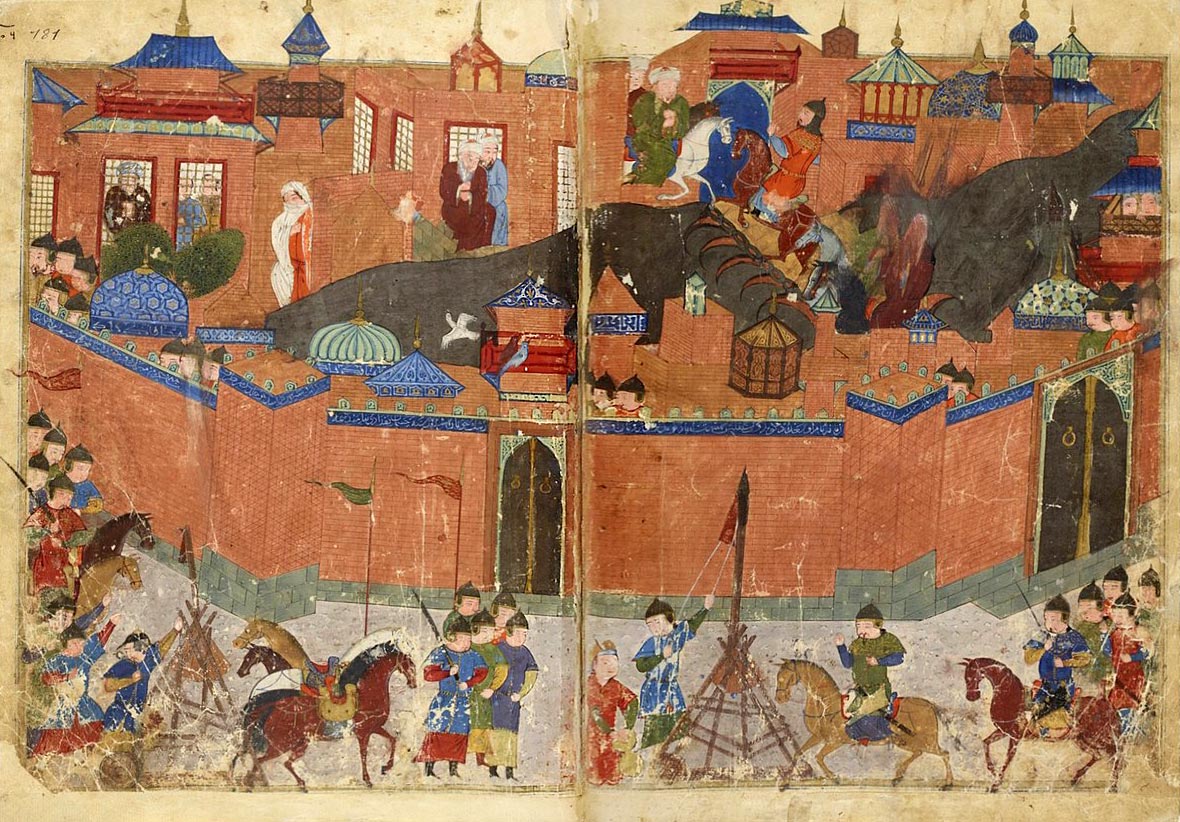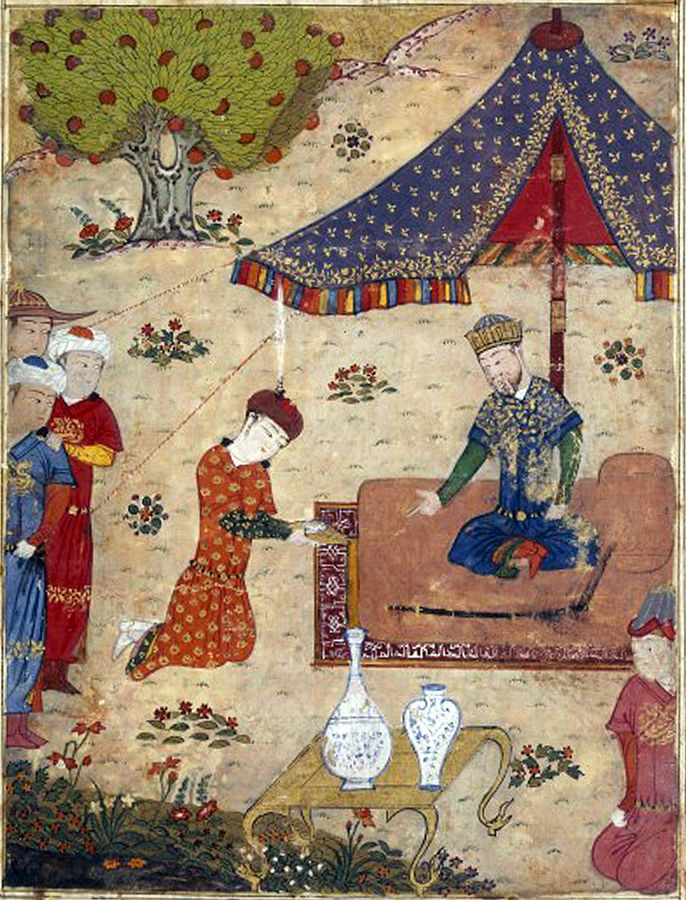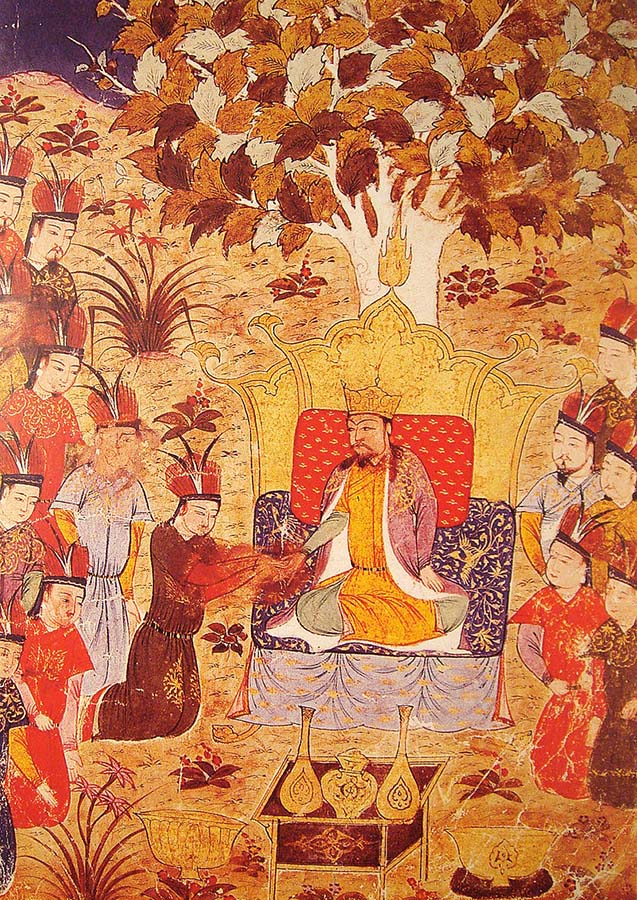Cross-Cultural Understanding: Mongol Political Rituals As Understood by Persian Scholars
As the Mongol Empire expanded westward in the 13th century, the lands of the Persianate world fell increasingly under Mongol dominion. The Mongols brought their own political and cultural norms, which their subjects were forced to adapt to. Various political rituals became part and parcel of life at court, and it became necessary for Persian scholars to engage with these rituals. These scholars, usually in political roles themselves, made use of Mongol terms when describing these moments of submission, reward, and penance.
The Mongols in the Islamic world
After the initial conquests of the Mongols in the 1220s, they gradually established themselves as the masters of most of the Persian-speaking Islamic world [Fig. 1]. Mongol domination was completed with the establishment of the Ilkhanate in the 1260s by Hulegu (d. 1265), a grandson of Chinggis Khan (d. 1227), which would continue until the mid-14th century. Much of the Middle East therefore had to acclimate to Mongol ways of doing things. The Mongols regularly made use of Persian officials to run their administrations, and it was these officials who saw themselves as mediators between the nomadic Mongol rulers and their sedentary Muslim subjects. Officials like ʿAta Malik Juvaini in the 1260s and Rashid al-Din in the early 1300s also undertook the writing of histories of the Mongols. It is in these works that we see these officials’ understanding of Mongol political rituals.

Fig. 1: The fall of Baghdad to the Mongols. (Bibliothèque nationale de France, Département des Manuscrits, Division orientale, Supplément persan 1113, fol. 180v-181)
Favour, reward, service, and gifts
Mongol political rituals centred on symbolic acts of submission, and the performance of loyalty, both by the ruler in the form of favours and rewards, and by the subject in the form of outstanding acts of service. The ritual which showed the ruler’s benevolence, gratitude, and provision to his subject is called soyurghamishi in Persian sources. This ritual involved the subject coming into the ruler’s presence and receiving or asking for some sort of benefaction from the Mongol ruler. At times, the swearing of oaths also took place in this ritual, binding ruler and ruled to the great principle by which the subject provided utmost loyalty and service, and the ruler responded with protection, sustenance, and favour. Often, the first type of soyurghamishi granted was the subject’s own life, showing the ruler’s mercy and forgiveness, and putting the subject forever in the ruler’s debt. More concrete forms of favours included money, precious gems, horses, and robes of honour, sometimes the very robes of the ruler himself. 1 Soyurghamishi often meant a change of status, a promotion or a confirmation of the position of a subordinate ruler. One of the most notable favours that a Chinggisid ruler could give was human: the control of a local group or a daughter in marriage. This was only conferred for the most significant political submissions or for the most dutiful service.
In return for such favours, subjects were expected to regularly show their own performance of loyalty, known as tikishmishi. This ritual was regularly a response to, or a presage to, the ruler’s soyurghamishi. This ritual usually often involved kneeling, the offering of an alcoholic beverage, giving gifts, the sacred number nine, and the welcoming of the performer into the ruler’s presence [Fig. 2]. It was the giving of gifts which was the most notable, showing the subject’s willingness to hand over tribute or booty, a very important step in the loyalty process for the Mongol rulers. The gifts that were given could take many forms, but regularly included horses, the key to Mongol military dominance. With the performance of this ritual, subjects showed their continued or renewed submission to their ruler. It was regularly performed after a subject had committed a transgression. The symbolism involved performing the ritual outside the camp, then being let into the ruler’s camp again. This act captured this passage from a state of disobedience and disfavour to a state of submission and intimacy.

Fig. 2: The Ilkhan Ahmad Teguder receives an ambassador’s gifts. (Bibliothèque nationale de France)
Sharing a cup
Drinks were of huge importance to the Mongols, not only as something to be consumed, but as materials with symbolic meaning. Mare’s milk, known as qumiss or airag, was poured on the ground in religious ceremonies and on the swearing of oaths, such as that of blood brotherhood, known as anda. 2 A specific ceremony called otok was a common occurrence in Mongol society, which entailed the offering of wine (or another alcoholic substitute) based on hierarchical status at important events. Persian chroniclers regularly mention the ritual of presenting a cup to a ruler, known as kasa-giri, which is likely a translation of the Mongol term. It seems that this Mongol tradition became a regular event in the Persianate world as well, and Persian chroniclers tell of this ritual often. At times, kasa-giri accompanied tikishmishi, in which the supplicant presented a cup or goblet to the ruler, and if the ruler accepted, the supplicant’s request would be granted [Fig. 3]. Rejecting the cup was a sign of disfavour, and the supplicant would need to prove his loyalty. This ritual carried great meaning, and serious insult could be taken by those who believed it was performed in the wrong way.

Fig. 3: Tolui presents a cup to his brother Ogodei Qa’an. (Reproduction in Genghis Khan et l’Empire Mongol by Jean-Paul Roux, collection “Découvertes Gallimard” (nº 422), série Histoire)
Penance and forgiveness
Both tikishmishi and a new term, uljamishi, were rituals by which subjects could return from a state of disobedience into the ruler’s good graces. It is notable that in both ceremonies, there were instances of rulers rejecting subjects’ opportunity to perform the ritual. This indicates that the ruler was either irrevocably estranged from his subject, which would mean his execution was imminent, or that the conditions for the performance of the ritual had not yet been met. This latter case usually meant that a recalcitrant subject had not gone far enough in proving his loyalty. Uljamishi certainly carried the idea of penance. One of the most interesting cases we have where this ritual was performed was by three sons of Chinggis Khan, Ogodei (d. 1241), Chaghadai (d. 1242), and Jochi (d. 1227) (or Tolui d. 1232). In their conquest of Khwarazm, the sons were accused of arguing amongst each other and withholding booty from their father, the second of which was a much more serious crime. Chinggis was livid and refused to see them for days, until his commanders convinced him to allow the sons to perform uljamishi to him and receive his favour once more. These rituals were, thus, not only for foreign rulers and Mongol commanders, but applied even to the royal family itself.
While some of these terms faded into obscurity, others became key concepts within Persian political terminology for centuries. Soyurghamishi and tikishmishi continued to be used by Timurid historians of the early modern period. Meanwhile, the word soyurghal, linked to soyurghamishi, came to mean a hereditary land grant, and was used by the Timurids, the Safavids, and the Mughals. The continuity between Persian historians of different eras explaining the rituals of their Turco-Mongol rulers meant that these were familiar concepts to these scholars, who likely had to perform the rituals themselves at some point in their careers. These historians sought to explain Mongol political culture, and, while they often used Persian words to elaborate upon these ideas, they continued to speak in the cultural language of their Turco-Mongol patrons.
Toby Jones is a PhD graduate from Leiden University, where he is also a lecturer. His research focuses on the Mongols as well as the social and political history of the Middle East more broadly. Email: t.x.jones@hum.leidenuniv.nl